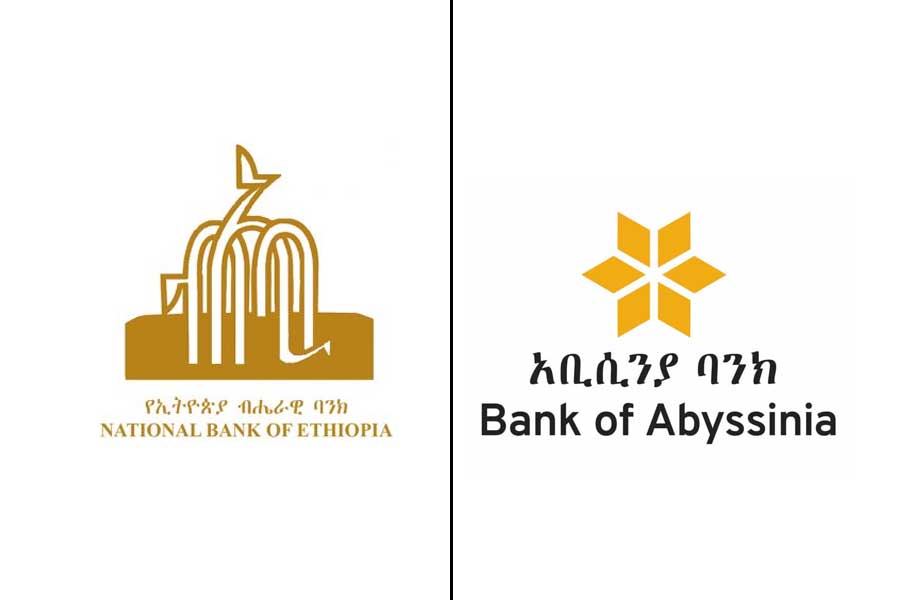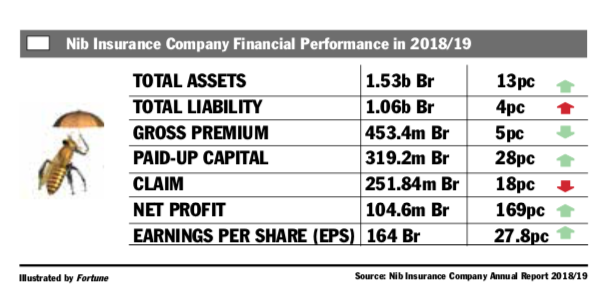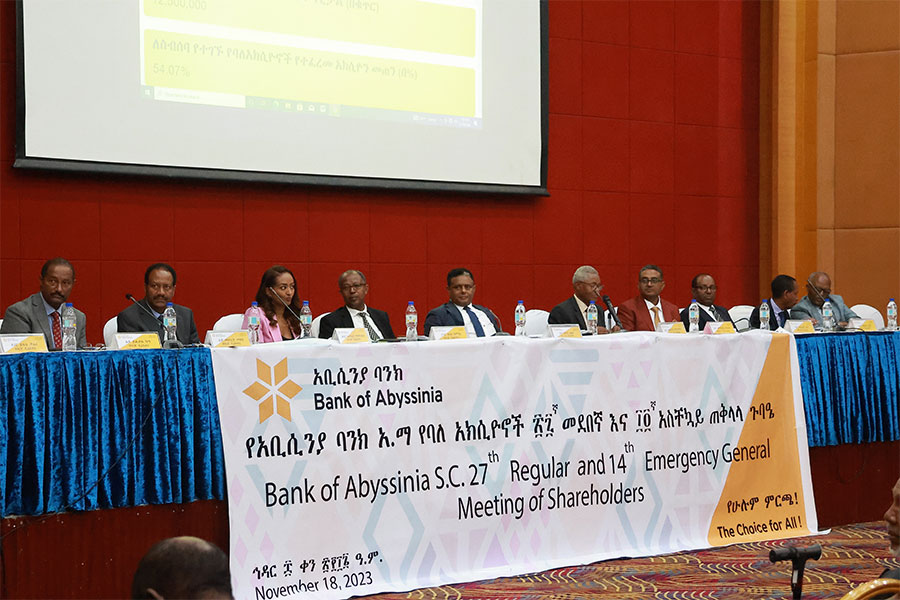
Radar | May 04,2019
Abyssinia Bank registered a net profit of 562.8 million Br in the last financial year, a 10pc increase. But dividends to shareholders declined to 6.1 Br per share.
During the previous 2016/17 financial period, the bank registered a 40pc growth and paid out 8.7 Br per share.
Its president, Mulugeta Asmare, blamed stringent laws enacted by the central bank as the major cause of the performance slowdown.
The central bank's revisions include increasing savings and time deposit interest rates by two percentage points, imposing a credit cap on non-export and non-manufacturing businesses, implementing a new law that orders banks to cede 30pc of their foreign exchange earnings to the central bank, and retaining the same percentage in bank reserves.
"These regulations have affected the performance of our Bank," Mulugeta told Fortune.
Meseret Taye, the Bank's board chairperson, agrees with the president.
"The National Bank of Ethiopia has endorsed multi-faceted and stringent regulatory requirements. These rules have negatively impacted the performance of commercial banks," wrote Meseret in the shareholders address of the Bank's financial statement.
Abyssinia Bank registered a net profit of 562.8 million Br in the last financial year, a 10pc increase. But dividends to shareholders declined to 6.1 Br per share.
Mulugeta also attributed the slow down of the economy to the decline in growth.
Revenues from financial intermediation, however, did contribute to the profit growth of the Bank. Abyssinia's revenue from interest on loans and advances and NBE bills soared to 2.7 billion Br, a 70pc increase from the previous year.
The Bank’s investment in NBE bills increased by 21 pc to 6.3 billion Br. Its assets also reached 32 billion Br, a 21pc increase from the preceding year. The ratio of liquid assets to total assets also increased by 0.7 percentage points to 14pc, while the ratio of liquid assets to total deposits rose to 17.4pc.
Deposit mobilisation increased to 25.7 billion Br and loan disbursement grew to 18 billion Br. The Bank’s loan-to-deposit ratio reached 68.9pc, which is above the industry average.
“As we have a genuine and loyal customer base in the export and manufacturing sector, we have managed to disburse sufficient loans,” Mulugeta added.
During the last financial year, the Bank made major investments, including investing 87 million Br in the construction of a 10-storey building in Semein Mazegaja on Belay Zeleke Street. The Bank also upgraded its core banking system and built a new database centre with an additional 110 million Br investment. In addition, the Bank is building offices in Hawassa, with 80pc of the construction completed to date.
The Bank's capital and non-distributable reserve, including revaluation reserve, reached 3.8 billion Br. Its paid-up capital reached 2.5 billion Br, a 42pc increase.
During the last fiscal year, expenses for salary, employee benefits and general administration also rose. For wages and benefits, the Bank spent 862.5 million Br, a 33.9pc increase from the reporting period two years ago. The general administration cost also soared by 20pc to 471.2 million Br.
“The revision of the company’s performance for the two years prior have affected the current report,” argued Mulugeta. “We are obliged to register the benefit of the employees as a provisional cost.”
The number of employees reached 5,825, a 16.3pc increase from the previous year. The Bank opened 53 new branches to reach a total of 286. It also trained 98pc of its employees on 100 operational subjects.
Abyssinia's liquidity ratio, the measure of a company's liquidity and how easily it can service debt and cover short-term liabilities, has improved. Cash and bank balance rose by 30.5pc to 4.5 billion Br.
The Bank's income from foreign exchange dealings, meanwhile, decreased to 11.9 million Br from 202.3 million Br.
"It is unusual and shocking," said Abdulmenan Mohammed, a financial analyst with over 15 years of experience in the United Kingdom and Ethiopia. “The Bank should thoroughly investigate these factors.”
But Mulugeta said it was out of the Bank's hands.
"While we were trying to live within the [central bank's] credit cap, we lost some clients," Mulugeta said.
Abyssinia's provision for doubtful loans, advances and other assets also soared from 63.1 million to 118.3 million in the reporting period.
“The increase is alarming,” argued Abdulmenan. “The management should investigate what caused such an increase in bad loans, advances and other assets.”
Bank officials believe the doubtful loans are not significant and were well managed during the reporting period.
The bank's non-performing loan ratio stood at 1.3pc, lower than the industry limit of five percent.
PUBLISHED ON
Dec 05,2018 [ VOL
19 , NO
971]

Radar | May 04,2019

Fortune News | Oct 30,2022

Radar | Jun 04,2022

Featured | Jan 28,2023

Radar | Jul 24,2021

Fortune News | Sep 24,2018

Fortune News | Mar 12,2022

Fortune News | Dec 14,2019

Radar | Jan 26,2019

Radar | Nov 20,2023

Dec 22 , 2024 . By TIZITA SHEWAFERAW
Charged with transforming colossal state-owned enterprises into modern and competitiv...

Aug 18 , 2024 . By AKSAH ITALO
Although predictable Yonas Zerihun's job in the ride-hailing service is not immune to...

Jul 28 , 2024 . By TIZITA SHEWAFERAW
Unhabitual, perhaps too many, Samuel Gebreyohannes, 38, used to occasionally enjoy a couple of beers at breakfast. However, he recently swit...

Jul 13 , 2024 . By AKSAH ITALO
Investors who rely on tractors, trucks, and field vehicles for commuting, transporting commodities, and f...

Jun 28 , 2025
Meseret Damtie, the assertive auditor general, has never been shy about naming names...

Jun 21 , 2025
A well-worn adage says, “Budget is not destiny, but it is direction.” Examining t...

Jun 14 , 2025
Yet again, the Horn of Africa is bracing for trouble. A region already frayed by wars...

Jun 7 , 2025
Few promises shine brighter in Addis Abeba than the pledge of a roof for every family...